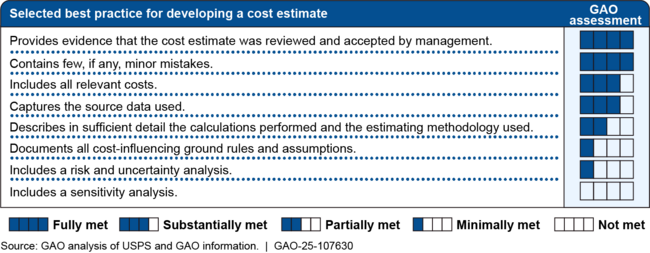U.S. Postal Service: Reviews of Proposed Facility Consolidation Costs Met Some Best Practices but Could More Robustly Analyze Risks
Fast Facts
The U.S. Postal Service is consolidating some of its mail processing facilities. Before doing so, USPS must give public notice of the proposed changes and provide information on how the changes will affect costs, employees, and mail service.
But we found that USPS's process for estimating the costs of these changes doesn't align with best practices we considered. For example, USPS doesn't document all the assumptions and methodologies it uses to develop cost estimates. This information would help decision-makers and oversight groups better understand any risks or uncertainty involved in the estimates.
Our recommendations address this issue.
Package Sorting at a U.S. Postal Service Processing Facility

Highlights
What GAO Found
The U.S. Postal Service (USPS) uses a multistep process—called Mail Processing Facility Reviews (MPFR)—to review proposed consolidations to mail processing facilities. As part of that process, USPS provides public notice and an opportunity for public input on proposed consolidations. USPS also analyzes the effects that proposed consolidations may have on costs and savings, USPS employees, and mail service performance. Since starting the MPFR process in July 2023, USPS has initiated 59 reviews. In May 2024, USPS announced it was pausing all in-process MPFRs until January 2025. According to USPS's announcement, this decision was in part a response to concerns from the public and Congress about the effects of facility consolidations. During this pause, USPS announced changes in scope for 16 MPFRs.
GAO found that the cost and savings analysis (cost estimate) USPS conducts as part of the MPFR process aligned with (i.e., fully or substantially met) four selected best practices but did not align with (i.e., partially met, minimally met, or did not meet) four others.
Extent to Which U.S. Postal Service's (USPS) Cost Estimate for Mail Processing Facility Reviews Aligned with Selected Best Practices

Specifically, GAO found that USPS's MPFR documentation lists few ground rules and assumptions related to costs and does not explain how USPS determined the assumptions. Nor does MPFR documentation describe some methodologies used in the analysis. Without such documentation, decision-makers and oversight groups may have concerns about the credibility of cost estimates and may not have complete information for decision-making and oversight. Additionally, USPS's MPFR documentation does not include an assessment of how different assumptions affected the underlying cost estimate (i.e., a sensitivity analysis). Moreover, MPFR documents include uncertainty ranges related to the cost estimates but do not explain how USPS determined the ranges (i.e., a risk and uncertainty analysis). Without analyses of sensitivity, risk, and uncertainty, USPS cannot determine the degree of confidence it has in expected cost savings from proposed consolidations. These analyses are particularly important given that USPS's facility consolidations are taking place in a rapidly changing USPS operational environment.
Why GAO Did This Study
USPS plays a critical role in the nation's communications and commerce. In fiscal year 2024, USPS delivered 112 billion pieces of mail and packages. However, for years USPS has struggled financially. As part of its 10-year strategic plan, USPS is redesigning its mail processing and delivery network to improve its service performance and financial viability. MPFRs are a key element of this effort, as they allow USPS to evaluate whether potential consolidations of mail processing facilities will result in cost savings and operational improvements.
GAO was asked to review the MPFR process. This report addresses (1) USPS's process for reviewing proposed consolidations to mail processing facilities, and the number of such reviews that USPS has initiated; and (2) the extent to which the cost and savings analysis that USPS conducts as part of the MPFR process aligns with selected best practices.
GAO reviewed MPFR policies and guidance, as well as other USPS documents; compared USPS's MPFR cost and savings analysis with eight selected GAO best practices for cost estimates; and interviewed USPS officials and relevant employee union leadership about the MPFR process.
Recommendations
GAO is making four recommendations, including that USPS include all cost-influencing assumptions and estimating methodologies, as well as analyses for sensitivity, risk, and uncertainty, in the MPFR process. USPS disagreed with the four recommendations. GAO maintains that its recommendations are warranted.
Recommendations for Executive Action
| Agency Affected | Recommendation | Status |
|---|---|---|
| United States Postal Service | The Postmaster General should direct the Chief Processing and Distribution Officer to include all cost-influencing ground rules and assumptions, along with their sources and supporting historical data, for MPFR cost estimates in relevant policies and guidance. (Recommendation 1) |
USPS indicated that it disagreed with this recommendation, and does not plan to take any action in response, because it views the current level of documentation-specifically for cost-influencing ground rules and assumptions-as sufficient. We maintain that improving documentation, in line with best practices, would be beneficial. We have found that a cost estimate that is reliable, and therefore a good basis for decision-making, is one that is well documented. We will monitor USPS's efforts regarding this recommendation.
|
| United States Postal Service | The Postmaster General should direct the Chief Processing and Distribution Officer to include all estimating calculations and methodologies used for MPFR cost estimates in relevant policies and guidance. (Recommendation 2) |
USPS indicated that it disagreed with this recommendation, and does not plan to take any action in response, because it views the current level of documentation-specifically for estimating calculations and methodologies-as sufficient. We maintain that improving documentation, in line with best practices, would be beneficial. We have found that a cost estimate that is reliable, and therefore a good basis for decision-making, is one that is well documented. Further, well-documented cost estimates can easily be repeated or updated and can be traced to original sources through auditing. We will monitor USPS's efforts regarding this recommendation.
|
| United States Postal Service | The Postmaster General should direct the Chief Processing and Distribution Officer to include a sensitivity analysis in MPFR cost estimates in relevant policies and guidance. (Recommendation 3) |
USPS indicated that it disagreed with this recommendation, and does not plan to take any action in response, because conducting these analyses is unnecessary and would add extensive additional analysis to a process that does not merit that level of effort. We continue to believe that conducting these analyses would require a low level of investment from USPS, and that the benefits of doing so would justify this effort. We have found that making decisions with an understanding of risks and uncertainties is critical to successfully achieving objectives. We will monitor USPS's efforts regarding this recommendation.
|
| United States Postal Service | The Postmaster General should direct the Chief Processing and Distribution Officer to include a risk and uncertainty analysis in MPFR cost estimates in relevant policies and guidance. (Recommendation 4) |
USPS indicated that it disagreed with this recommendation, and does not plan to take any action in response, because conducting these analyses is unnecessary and would add extensive additional analysis to a process that does not merit that level of effort. We continue to believe that conducting these analyses would require a low level of investment from USPS, and that the benefits of doing so would justify this effort. Robust risk and uncertainty analysis can inform decision-makers about the potential range of costs and cost drivers. We will monitor USPS's efforts regarding this recommendation.
|
